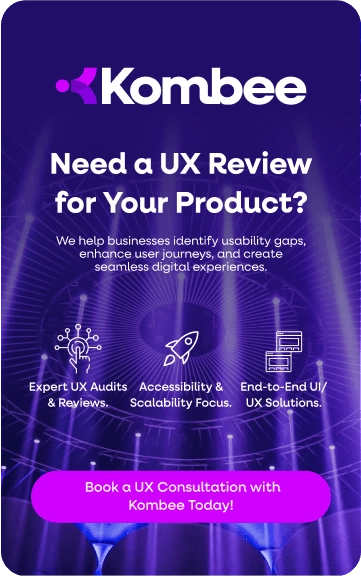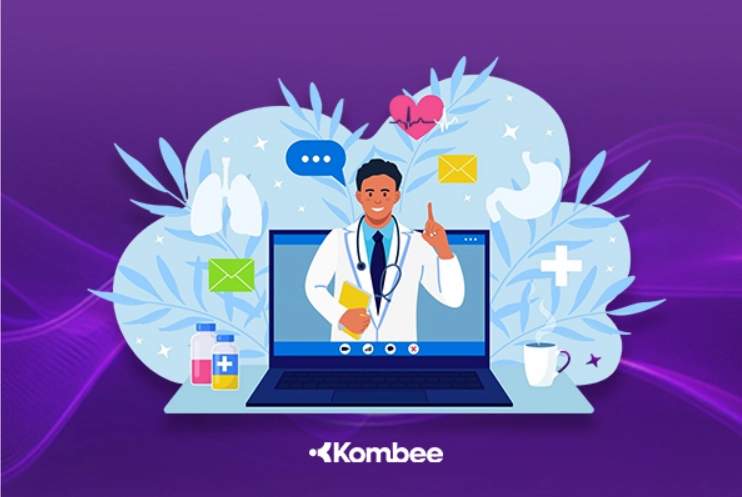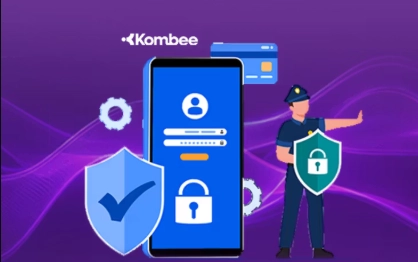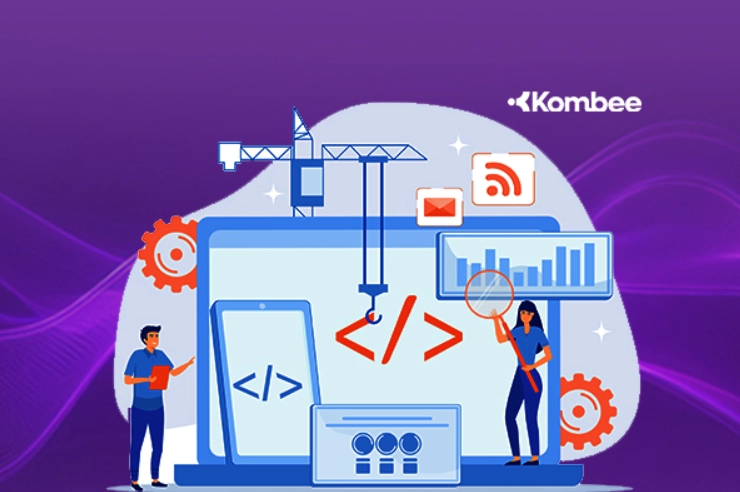Introduction
Have you ever stopped to think about the types of mobile applications your company could develop to increase engagement and drive growth? Mobile apps are critical to helping businesses reach customers. Additionally, a successful mobile app strategy guarantees your app accomplishes business objectives, reaches the appropriate audience and utilizes the best tech. It also assists in prioritizing features, budgets and scalability, guaranteeing long-term success as well as maximizing ROI.
In this blog, we’ll discuss the different types of mobile applications based on different aspects and how businesses can build and why strategy is key.
Mobile Apps by Technology: The Technical Foundations
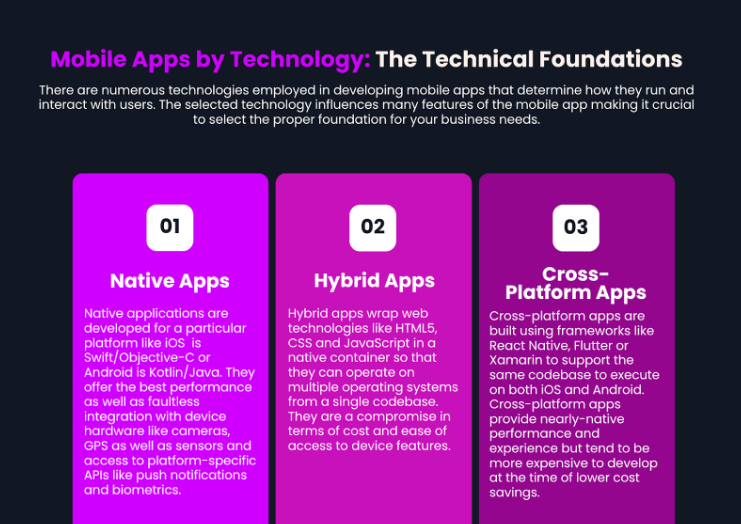
There are numerous technologies employed in developing mobile apps that determine how they run and interact with users. The selected technology influences many features of the mobile app making it crucial to select the proper foundation for your business needs.
1. Native Apps
Native applications are developed for a particular platform like iOS is Swift/Objective-C or Android is Kotlin/Java. They offer the best performance as well as faultless integration with device hardware like cameras, GPS as well as sensors and access to platform-specific APIs like push notifications and biometrics.
Native apps provide the best user experience and are best suited for apps that need heavy graphics like games, AR/VR, complex workflows or high security like banking apps. However they are more time-consuming and expensive to develop particularly if developing for several platforms. Custom mobile apps for business that require high performance and tight security are typically native apps.
2. Hybrid Apps
Hybrid apps wrap web technologies like HTML5, CSS and JavaScript in a native container so that they can operate on multiple operating systems from a single codebase. They are a compromise in terms of cost and ease of access to device features.
Hybrid apps have access to device APIs and hardware but are possibly slower or less integrated than native apps. Best mobile apps for business like Instagram utilize a hybrid approach to achieve broad accessibility across platforms while keeping the maintenance simple.
3. Cross-Platform Apps
Cross-platform apps are built using frameworks like React Native, Flutter or Xamarin to support the same codebase to execute on both iOS and Android. Cross-platform apps provide nearly-native performance and experience but tend to be more expensive to develop at the time of lower cost savings.
Cross-platform development is best suited for businesses that want to achieve maximum coverage without repeating the same work on multiple platforms. But some features may still need custom native code across categories of mobile application.
Kombee provides expert mobile app development services tailored to meet your specific business needs. Our team ensures that your app's functionality, design and performance are aligned with your goals, ensuring long-term success.
Mobile Apps by Audience: Who is the App For?
Best mobile apps for business are created with a target audience in mind. Knowing who your app's audience is means the features ensure the best engagement.
1. Business-to-Consumer
B2C mobile apps are made for single consumers with easy-to-use interfaces as well as mass popularity and personalized experiences. Features tend to include social features, gamification and push notifications. Examples include shopping mall apps, fitness trackers and social networks.
2. Business-to-Business
B2B apps are business-focused with enterprise integration as well as scalability and security in mind. Typical use cases are CRM applications, project management software and analytics. Examples are Salesforce, Slack and QuickBooks.
3. Internal/Employee Apps
These apps are built for a company's workers to streamline operations as well as enhance productivity and help with compliance. Features may involve resource management, project tracking, HR tools and internal communication. Examples are customized inventory systems, internal messaging platforms and time-tracking software.
Mobile Apps by Functionality: What Your App Will Actually Do
Mobile apps are created to perform definite functions that fulfill business objectives and user requirements. Knowing the most important features your app will provide assures it will be worth it and satisfy user expectations.
1. Social & Communication Apps
They bring people together, allow them to exchange information and form communities. Common characteristics are messaging, live stories, user profiles, content streams, notifications and group conversations. Examples are Facebook, TikTok, WhatsApp and Slack. Social app developers are concerned with engagement mechanisms as well as privacy controls and real-time interaction.
2. Entertainment & Media Apps
Entertainment apps provide on-demand content including videos, music, podcasts and games. These apps usually combine streaming, recommendations as well as offline watching/listening and social sharing. Some examples are Netflix, YouTube, Spotify and Candy Crush.
3. Productivity & Utility Apps
These types of mobile applications assist with task management, calendars as well as documents and daily routines. Productivity apps are advantageous both in professional and also personal life to facilitate streamlined workflows. Examples include Evernote, Trello, Google Drive and Slack.
4. E-Commerce & Retail Apps
E-commerce applications enable mobile shopping, product search as well as secure checkout and order tracking. Typical features encompass wishlists, recommendations as well as loyalty rewards and push alerts. Examples are Amazon, eBay and Shopify.
5. Finance Apps
Finance apps assist with managing money, monitoring spending and investing. They often consist of budgeting tools, real-time account checking as well as bill payments and investment tracking. Security is paramount with biometric logins and protected transactions. Examples are Mint, Revolut and PayPal.
6. Health, Fitness & Wellness Apps
These apps monitor exercise and health statistics thus assisting in attaining wellness objectives. Capabilities include steps tracked, caloric burn counted, workout routines and wearables integration. Examples are MyFitnessPal, Strava and Headspace.
7. Educational & E-Learning Apps
These categories of mobile application offer interactive learning, tutorial, exams and progress monitoring for learners of all ages. They may include video lessons, gamification, discussion forums and certifications. Examples are Duolingo, Khan Academy and Coursera.
8. Travel & Navigation Apps
Travel apps assist in trip planning, booking as well as navigation and discovering new locations. They provide maps, GPS routing, live information as well as reviews and loyalty programs. Examples are Expedia, TripIt and Google Maps.
Case Study: An example of how a well-designed mobile app can meet business needs is Kombee’s work with Squash Players. Kombee developed a feature-rich mobile app with secure authentication to protect user data and implemented cloud-hosted storage and syncing to ensure smooth, global access to information and much more. These solutions enabled seamless matchmaking, score tracking and event management, helping revive interest and engagement in the sport.
How to Select the Proper Mobile App Type
The selection of the proper app type is about weighing different factors:
- Business Goals: Determine what you wish to accomplish brand awareness, revenue, productivity or user engagement.
- Target Users: View user demographics, platform affinity and usage habits.
- Key Features: Consider the requirement of device hardware access, offline functionality or platform integration.
- Cost & Time: Natively developed apps deliver highest performance but at a higher cost, with hybrid and cross-platform options striking a balance between cost and time.
- Future Evolution: Design for future growth, extensibility and integration with other systems.
- Security & Compliance: This is imperative for finance, health and enterprise apps.
Choosing between a native, hybrid, or cross-platform app requires careful consideration. If you're interested in learning more about the benefits of a hybrid app for both iOS and Android, check out this insightful blog: Need an App That Works on Both iOS and Android? Why Hybrid App Is Your Best Bet.
Long-Term Success Strategy Tips for App Planning
To make your app a long-term success below here are some tips:
- User-Centric Design: Prioritize simple UX/UI and accessibility.
- Scalable Architecture: Plan your app with room for future features and added user load.
- Data-Driven Decisions: Utilize analytics to monitor user interaction and optimize features.
- Regular Updates: Release new features and patch bugs to keep the app fresh.
- Marketing & Onboarding: Spend money on app store optimization and easy user onboarding.
- Feedback Loops: Make feedback channels available to improve your app based on user feedback.
Conclusion
Companies can build different types of mobile applications each designed for particular technologies, functionalities and audiences. The best solution is based on your strategic goals as well as customer needs and resource availability. Knowing the technical foundations, functionalities and target audience and making provisions for long-term growth. Are you still wondering how to start with your mobile applications? Contact Kombee to have all your questions answered.
Frequently Asked Questions
1. What type of mobile app is best for startups or small businesses with limited budgets?
For small businesses with limited budgets, hybrid apps are a great choice. They offer a balance between cost and functionality, allowing businesses to reach both iOS and Android users without the expense of building separate native apps for each platform.
2. Can I change my app type later if my business grows?
Yes, it’s possible to change your app type as your business grows. For example, you can start with a hybrid app and later transition to a native app or cross-platform app to enhance performance and scalability as your needs evolve.
3. What kind of mobile app should I build to scale with my business growth?
A cross-platform app or native app with a scalable architecture is ideal for growth. These apps allow you to handle increasing traffic, support more features, and integrate seamlessly with other business systems, ensuring your app evolves with your expanding business.
4. What are some common features of e-commerce mobile apps?
Common features of e-commerce mobile apps include product browsing, secure checkout, order tracking, payment gateway integration, push notifications, customer reviews, wishlists, loyalty programs, and personalized product recommendations, all designed to enhance user experience and increase conversions.



